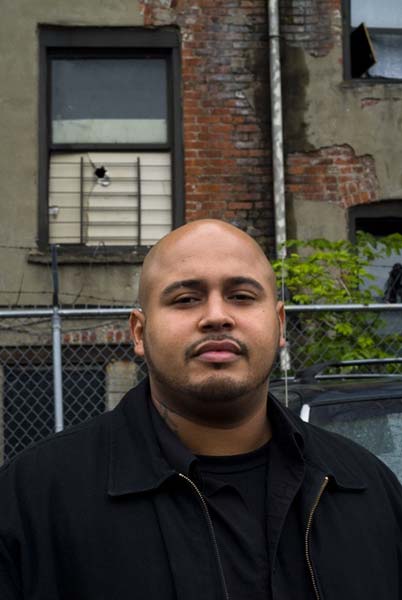
Photo by: Alice Proujansky
Cesar Guzman, 28, outside of the building where his family lives at 422 East 178th Street in the Bronx. The exterior is deteriorating, as well as the interior. Guzman blocked off the window, which was missing a pane.
From a tenant’s point of view, one major problem with “predatory equity” is that if a real estate investor pays too much for a property – realizing post-purchase that the building’s rents will never be enough to pay back the mortgage debt assumed – the investor will start to cut costs by reducing maintenance of the property.
That fear has been fully realized at the 16 buildings in the Bronx owned by the Ocelot Company. Living conditions have deteriorated among many of these 400 apartments to the point that half the buildings are in the Alternative Enforcement Program aimed at compelling improvements to the city’s worst residential buildings.
See slideshow for photos inside one Ocelot building on East 178th Street in the Mount Hope neighborhood of the Bronx.
The debt on the Ocelot buildings – which are estimated to be at least 50 percent overleveraged, or worth only about half the purchase price – was taken over by Fannie Mae, the government-sponsored enterprise chartered by Congress to help make funds available to homebuyers (which received a federal bailout in September), in mid-2007. The same year, Fannie Mae also purchased the $700 million in debt on a much larger portfolio – 4,000 former Mitchell-Lama apartments owned by Urban American Management. And according to tenants, advocates and elected representatives, living conditions have continued to decline in those buildings as well.
Tenants and elected officials rallied last week in Harlem to urge Fannie Mae to take a more active role in ensuring upkeep of the properties – so that the mold, leaks, holes and deterioration common to Ocelot properties not become the norm across the 7,000 overleveraged apartments in the Bronx, Manhattan and Roosevelt Island for which Fannie Mae holds the debt.
~
“We stand with the tenants of the Urban American Management portfolio to urge Fannie Mae to live up to the spirit of the law to ensure that these buildings are kept in good condition,” U.S. Rep. Charles Rangel of Harlem said in a statement. “We cannot wait until these buildings fall off a cliff and must do everything we can now to protect our tenants.”
For most real estate speculators and investors, “they don’t have to care about tenants, they don’t have to care about affordable housing,” says Dina Levy, director of organizing and policy for the Urban Homesteading Assistance Board. “With Fannie Mae, that’s not true. It’s had a social mission since its inception.”
The same day as the rally, May 28, Fannie Mae responded, issuing a statement saying it is committed to meeting with affected parties to hear problems and work toward solutions. “We have ordered on-the-ground inspections of each of the buildings in question and, to the extent we can as a mortgagee and secondary market participant, we are taking steps through our servicers to compel building owners to properly maintain the properties,” said Brian Faith, managing director for communications on New York rental properties.
Levy said advocates are “generally very optimistic” about Fannie Mae’s response and pledge to work together. “We’re hopeful for a real dialogue that helps us figure out how to solve this,” she said – especially because new cases of troubled overleveraged properties and foreclosures crop up all the time, and the fallout for tenants, buildings and neighborhoods does not promise to end in the near future.
Note: City Futures, City Limits’ parent nonprofit, is a subtenant of the Urban Homesteading Assistance Board, mentioned above, and UHAB Executive Director Andy Reicher is chairman of the board of City Futures.








